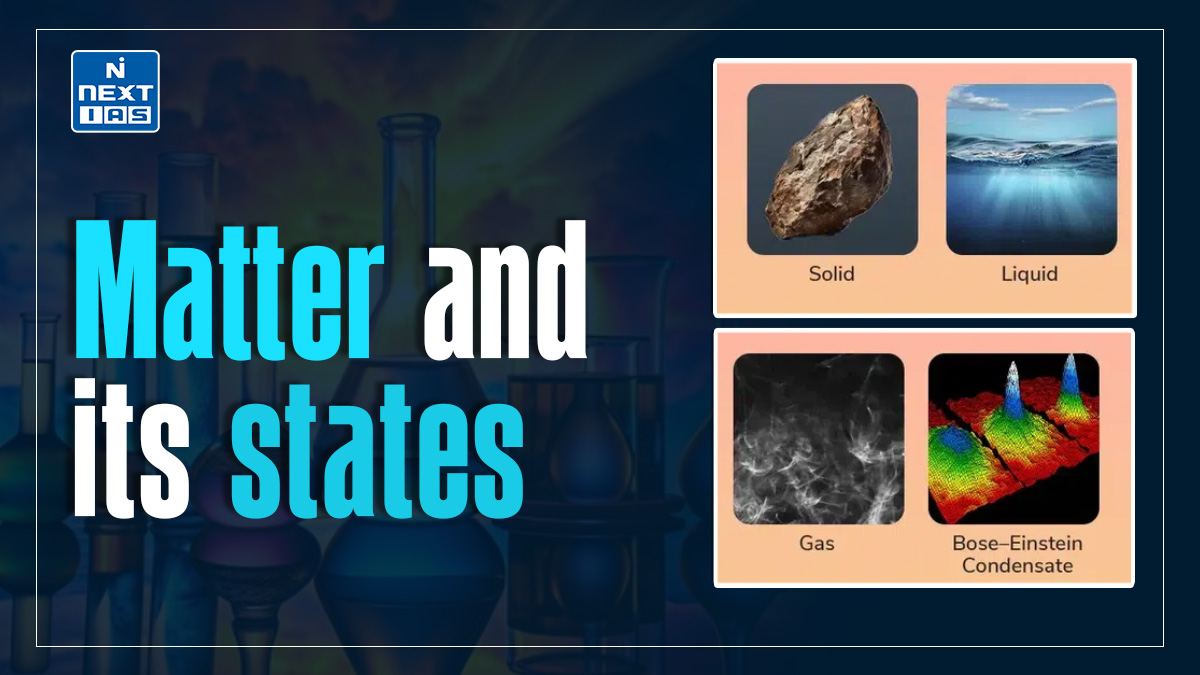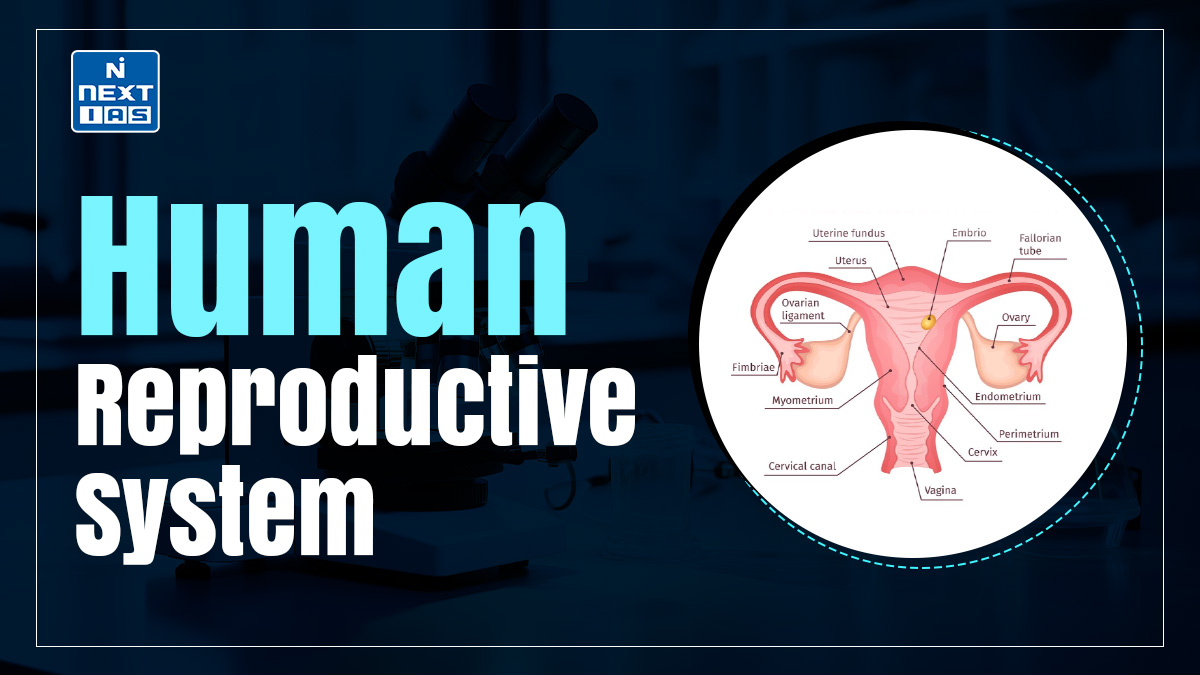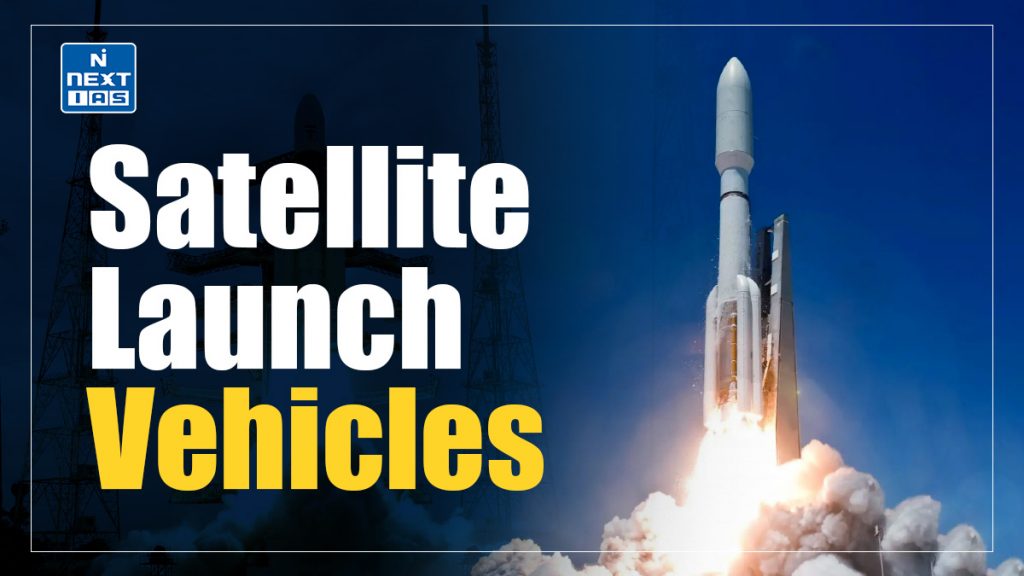
A Satellite Launch Vehicle (SLV) is a rocket designed to transport satellites into space and place them in designated orbits. These vehicles play a crucial role in deploying satellites for communication, weather forecasting, navigation, and scientific research. SLVs vary in size and capability, catering to different mission requirements and payloads.
About Launch Vehicle Programmes of India
- India’s Launch Vehicle Programme, led by the Indian Space Research Organisation (ISRO), focuses on developing indigenous rockets to place satellites in orbit.
- It began with the Satellite Launch Vehicle (SLV) in 1980, followed by the Augmented Satellite Launch Vehicle (ASLV). The Polar Satellite Launch Vehicle (PSLV), introduced in the 1990s, became a reliable workhorse for launching various satellites, including for foreign clients.
- The Geosynchronous Satellite Launch Vehicle (GSLV) and its advanced variant, GSLV Mk III, enable heavier payloads and interplanetary missions.
- India’s latest development, the Small Satellite Launch Vehicle (SSLV), offers quick, cost-effective launches for small satellites, expanding the nation’s space capabilities.
Key Facts about Satellite Launch Vehicles (SLVs)
- Purpose: SLVs are used to transport satellites into specific orbits around Earth or beyond.
- Types of Orbits: Common target orbits include Low Earth Orbit (LEO), Geostationary Orbit (GEO), and Polar Orbit.
- Stages: Most SLVs have multiple stages, each with its engine and propellant, which detach as the rocket ascends.
- Propulsion: They use solid, liquid, hybrid, or cryogenic propellants for thrust.
- Reusable SLVs: Some modern SLVs, like SpaceX’s Falcon 9, are partially reusable to reduce costs.
- India’s Achievements: India’s PSLV has launched over 300 satellites, while the GSLV launched Chandrayaan and Mangalyaan missions.
- Launch Sites: Launch vehicles require specially designed launch pads and ground infrastructure.
- Global Competition: Countries like the U.S., Russia, China, and India compete in launching commercial and government satellites.
- SSLV Trend: Smaller launch vehicles are gaining popularity for deploying small and nano-satellites quickly and efficiently.
- Challenges: Precise engineering is required to overcome challenges like atmospheric drag, gravity, and complex orbital insertion.
Advanced Satellites Launch Vehicles
Satellite Launch Vehicle (SLV)
- The SLV project was born out of the need for achieving indigenous satellite launch capability for communication, remote-sensing and meteorology. Satellite Launch Vehicle-3 (SLV-3) was the first experimental satellite launch vehicle. It was an all solid, four stage vehicle weighing 17 tonnes with a height of 22m and capable of placing 40 kg class payloads in Low Earth Orbit (LEO).
- After many successful launches, the SLV project culminated, paving the way to advanced launch vehicle project such as Augmented Satellite Launch Vehicle (ASLV), Polar Satellite Launch Vehicle (PSLV) and Geosynchronous Satellite Launch Vehicle (GSLV).
Augmented Satellite Launch Vehicle (ASLV)
- The ASLV was made to carry heavier payload than SLV-3. With a lift off weight of 40 ton, the 24m tall ASLV was configured as a five stage, all solid propellant vehicle, with a payload capability of 150 kg into the 400 km LEO. It proved to be a low-cost intermediate vehicle to demonstrate and validate critical technologies like strap-on technology, inertial navigation, bulbous heat shield, vertical integration, closed loop guidance, etc.
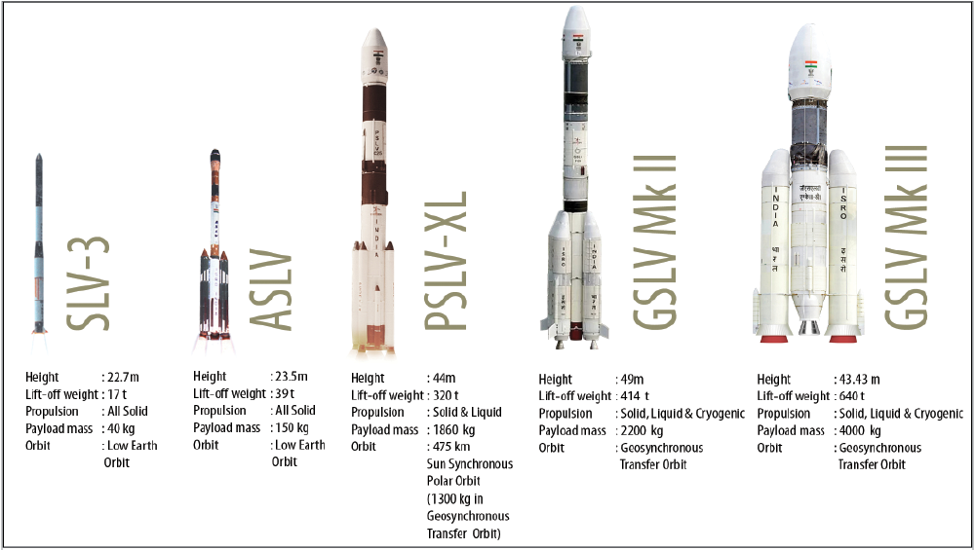
Polar Satellite Launch Vehicle (PSLV)
- Polar Satellite Launch Vehicle is the third generation launch vehicle of India. It is the first Indian launch vehicle to be equipped with liquid stages and the first launcher to gain operational status. It is a 44m tall vehicle, with lift-off mass of 295 ton. It is configured as a four stage, alternate solid and liquid propellant vehicle.
- It can take up to 1,750 kg of payload to Sun-Synchronous Polar Orbits of 600 km altitude. PSLV uses 6 solid rocket strap-on motors to augment the thrust provided by the first stage in its PSLV-G and PSLV-XL variants. However, strap-ons are not used in the core alone version (PSLV-CA).
- The PSLV has proven to be a reliable and versatile vehicle for diverse missions. As of 14 February 2022, the PSLV had completed 54 launches, with 51 successfully reaching their planned orbits. The fact that PSLV was used to place Chandrayaan-1 and Mangalyaan to the Moon and the Mars respectively, is a testimony of its versatility and reliability.
Geosynchronous Satellite Launch Vehicle (GSLV)
- Geosynchronous Satellite Launch Vehicle is the largest launch vehicle developed by India. This fourth generation launch vehicle is a three stage vehicle with indigenously developed Cryogenic Upper Stage (CUS), which is flight proven.
ISRO has renamed the GSLV-Mark III as LVM3 mainly to identify etc of placing satellites into a variety of orbits.
- ISRO has designed 3 staged programmes for the development of GSLV, i.e. GSLV-MK I, GSLV- MK II and GSLV- MK III. GSLV MK III is the heaviest and most powerful launch vehicle. It is 43 m tall, with lift off mass of 640 ton. It has a payload capacity of 4-5 tonnes for Geosynchronous Transfer Orbit (GTO) or about 10 tons to Low Earth Orbit (LEO), which is about twice the capability of the GSLV Mk II. It was used to launch Chandrayaan-2 spacecraft.
Reusable Launch Vehicle – Technology Demonstrator (RLV-TD)
- The RLV-TD is a series of technology demonstration missions that have been considered as a first step towards realizing a Two Stage To Orbit (TSTO) fully re-usable vehicle. The Reusable Launch Vehicle is like a winged aircraft that has been configured to act as a flying test bed to evaluate various technologies, namely, hypersonic flight, autonomous landing, powered cruise flight and hypersonic flight using air-breathing propulsion.
- This technology is being developed in phases through a series of experimental flights. The first in the series of experimental flights is the Hypersonic Flight Experiment (HEX) followed by the Landing Experiment (LEX), Return Flight Experiment (REX) and Scramjet Propulsion Experiment (SPEX).
| SOUNDING ROCKETS Sounding rockets are one or two stage solid propellant rockets used for probing the upper atmospheric regions and for space research. They also serve as easily affordable platforms to test or prove prototypes of new components or subsystems intended for use in launch vehicles and satellites. The launch of the first sounding rocket from Thumba near Thiruvananthapuram, Kerala on 21 November 1963, marked the beginning of the Indian Space Programme. |
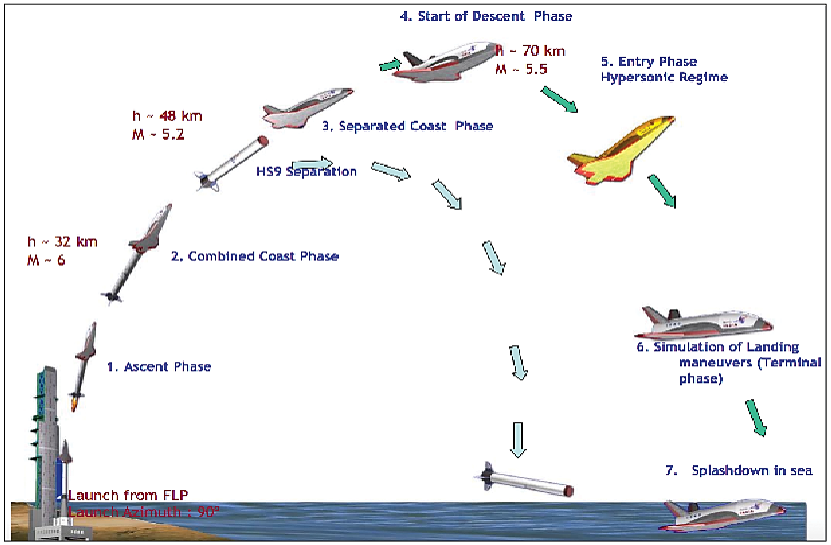
Applications of Satellite Launch Vehicles
- Communication Satellites:
- Enable TV broadcasting, internet services, and telecommunication networks across the globe.
- Earth Observation and Remote Sensing:
- Monitor climate, natural disasters, agriculture, and urban development.
- Navigation Satellites:
- Support GPS, GLONASS, and India’s NavIC systems for accurate positioning and navigation services.
- Weather Satellites:
- Provide meteorological data to predict weather patterns and monitor cyclones or storms.
- Scientific Research:
- Facilitate space missions and experiments to study Earth’s atmosphere, outer space, and celestial bodies.
- Defense and Surveillance:
- Deploy military satellites for reconnaissance, communication, and early warning systems.
- Commercial Satellite Launch Services:
- Countries and private companies offer SLV services to launch satellites for clients globally.
- Interplanetary Exploration:
- Enable missions to the Moon, Mars, and beyond, such as ISRO’s Chandrayaan and Mangalyaan missions.
- Space Tourism and Human Missions:
- Future SLVs aim to support human spaceflight and space tourism ventures.
- Small Satellite Deployment:
- SLVs like SSLV efficiently launch nanosatellites for educational and research purposes.
Way Forward
- The future of satellite launch vehicles lies in reusability, cost-efficiency, and miniaturization. Advancements in reusable rockets will reduce launch costs significantly, encouraging more frequent missions. Smaller, modular vehicles like SSLVs will cater to the growing demand for nanosatellite launches. Collaborations between governments and private space companies will drive innovation.
- Additionally, focus on green propellants will make launches environmentally sustainable. Emerging technologies such as 3D printing for rocket parts and AI-driven launch systems will further enhance reliability and operational efficiency.
Conclusion
Satellite Launch Vehicles (SLVs) are essential for advancing space exploration, communication, and global connectivity. They enable the deployment of satellites for diverse applications, including navigation, weather forecasting, scientific research, and defense. With advancements like reusable rockets and small satellite launchers, SLVs are becoming more efficient and cost-effective. Countries and private players are increasingly investing in this technology, driving innovation and competition. As space exploration grows, SLVs will play a critical role in enabling future missions and expanding our presence beyond Earth.
Further Reading:- Satellites: Size, Types & More
GS - 3
